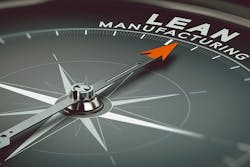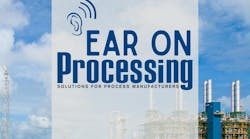Today’s U.S. manufacturing industry is in a period of radical reform. With disruptive innovators, regulatory changes and workforce gaps, manufacturers are being challenged to not only adapt, but also to transform. Lean transformation is a proven, highly effective strategy for increasing enterprise value. Based on the revolutionary principles of the Toyota Production System, lean describes a problem-solving approach and organizational culture change that drives continuous improvement. Its focus on identifying and eliminating waste can maximize efficiency in organizations of all types and sizes.
While many organizations have turned to lean to create an adaptable environment that values continuous movement and improvement, research shows that 70 percent of complex, large-scale, enterprise-change programs fail to accomplish their stated goals.
The reasons that transformations fail vary from a lack of employee engagement to inadequate management to poor, cross-functional collaboration. More often than not, however, points of failure can be traced back to the same root cause: an incomplete or inaccurate understanding of business opportunities prior to lean implementation. Company leaders often become caught up in simply "doing" lean rather than using lean to turn their strategy into action and cultivate a culture of customer satisfaction and employee motivation. They do what they can, rather than what they should, often because the should seems impossible. This traditional approach effectively sets limits on the improvement potential of the organization, sabotaging the transformation before it even begins.
Common miscues
During lean implementation, several common mistakes are made.
Lack of engagement: One of the most common pitfalls of a lean transformation is a lack of engagement from senior leadership. Without enthusiastic involvement from executives, other employees have difficulty understanding the intentions driving the lean transformation and connecting improvement activities to business opportunities. Those employees’ interests in and commitment to the system will wane, drastically reducing chances of success.
Heavy focus on cost-saving measures: To realize the full benefit of a lean transformation, organizations must have a cashing-in strategy. Many companies make the mistake of focusing their transformation on driving costs down, rather than driving value up. The former is a dead-end view, while the latter opens up a business to a near-limitless supply of possibilities. This is specifically where and how an effective transformation can enable and fund the deployment of a
Reluctance to commit to big goals: Perhaps the most detrimental point of failure companies encounter is the inability to alter their mindsets to see what’s possible. Corporate culture tends to foster a reluctance to commit to big goals and big change because failure often brings consequences. This fear of failure inhibits honesty and creativity, limiting the potential for improvement.
Overcome common barriers
To launch a successful lean transformation that significantly increases enterprise value, organizations must overcome these common barriers to a change initiative. It requires a meticulous diagnostic approach to implementation that identifies existing strategic improvement opportunities and constructs a customizable roadmap for achieving results. Companies should consider the four phases described in this section:
Phase 1: Data capture and preparation
An effective diagnostic should be a business-minded assessment, not an academic exercise for tactical lean zealots. It requires business and commercial acumen combined with an experienced eye to see and imagine possibilities. The approach must replicate the attitude and mentality of a prospective new business owner. That means using real data and taking nothing for granted. Because nothing is assumed, all subsequent evaluation is driven by a trustworthy source of knowledge that dramatically increases the potential for breakthrough improvements.
Phase 2: Current-state assessment
The current-state assessment is arguably the most important part of the diagnostic. Organizations can rapidly and systematically uncover their businesses’ improvement potential in this phase.
During this assessment, each business function in the end-to-end business process is analyzed to identify waste and improvement opportunities. This phase is intended to be a team-based exercise that puts pens in the hands of the people who actually do the work. It does not take place on a computer screen or a conference room wall; it is a "go-see" process that takes place where the work is done. This combination of on-site observation, employee input and business data is what makes scalable improvement possible.
By asking the critical question "so what" when problems are spotted, the team works together to find potential solutions that, when implemented, will solve the problems and add value to the enterprise. Strengths are identified and capitalized upon, and best practices are solidified — especially between business units or territories in which differences can be significant.
The team then assembles a dedicated data room where findings from the assessment and answers to the ‘"so what" questions are summarized in a prioritized and structured manner. The visual, tangible presentation of this information can have an enormous impact on the transformation’s success.
Leadership is often humbled to see how large the improvement opportunity can actually be, and everyone becomes excited and motivated by the ability to visualize the possibilities. The current-state assessment highlights a company’s strengths and weaknesses using data rather than opinions. This drives alignment and commitment to the true potential of the enterprise: helping answer the question, "What is the size of the prize?"
Phase 3: Strategic option evaluation & selection
Now that the "what" of the transition has been defined, the next step is to determine the "how." During this phase of the diagnostic, the team determines which strategic options for pursuing the identified goals are viable. The requirements and impact of each option are evaluated, and new breakthroughs are defined. An improvement hypothesis makes it easy to objectively rank and compare options.
Then comes decision time. The team must look at the possibilities and commit to what they will do. The ability to thoroughly evaluate and then choose strategic options puts the expected benefits, costs and plan of action clearly in focus for the entire company — before any action is taken. This provides an important opportunity to assess the level of appetite and commitment that exists within the business to make it happen.
Phase 4: Benefits hypothesis & report
The final phase of the diagnostic is a comprehensive report that summarizes the key outputs and findings from each of the prior three phases. It is essentially a record and reference of what the team found, what they committed to do, how they plan to do it and what they expect the results to be. The team can then develop a clear, time-based roadmap for achieving the desired results, which takes into account the size of the business, the level of effort required, the availability of resources and the culture of the organization. This provides the answer to the question, "How heavy is the lift?"
Conclusion
Large-scale companies across the globe and from many industries have leveraged diagnostic approaches to lean implementation for a successful transformation — and a rapid increase in enterprise value. This comprehensive approach provides upfront insight into the capabilities of a business and has the power to reveal huge opportunities that may be missing. It also helps an organization understand how to pursue those opportunities, allowing it to achieve results previously thought impossible.
Jon Armstrong is executive vice president of Simpler Consulting, an IBM Company. Before joining Simpler in 2004 Armstrong had 15 years of experience managing dynamic manufacturing environments. He became manager of consulting services in 2005, vice president of delivery in 2007, managing director for Simpler Consulting Ltd. in 2008, and now executive vice president. Previously, he held positions with Cummins Engine Company, American Axles, APW Electronics and Waukesha Bearings. At Simpler, Armstrong has led multiple-site transformations with the Royal Air Force, among other key projects.


